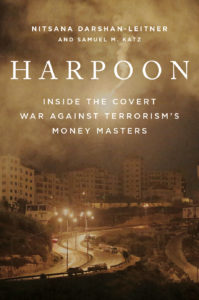She has been praised for winning multi-million-dollar lawsuits against terrorists, their financial backers and foreign governments in U.S. courts.
Through her organization, the Shurat Hadin-Israel Law Centre, Nitsana Darshan-Leitner’s goal is to bankrupt terrorism by stopping the flow of money that funds it, through massive civil suits and other legal actions, and by defending the victims of terror in court.
Her recently published book, Harpoon: Inside the Covert War Against Terrorism’s Money Masters, co-authored by Samuel Katz, reveals Israel’s secretive and powerful counterterrorism task force, code named Harpoon, and how it works to destroy terrorist financial networks. The stunning scope and imagination of their operations over the last 20 years makes it a thrilling and engrossing read.
In 2002, Darshan-Leitner got a call from Meir Dagan, the legendary head of Mossad. He was developing a covert unit to attack terrorists in a new way – through the money that fuelled their activities. It was a revolutionary change and would prove to be a game-changer – one that would be copied by virtually every other Western country.

The traditional approach of Israeli counterterrorist operations was military action: gather the evidence and target the command structure – the bomb builders, the planners, the attackers.
Dagan was frustrated by Israel’s conventional approach to warfare, as the country had been unable to stop the plethora of bus bombings, drive-by shootings and suicide attacks.
He wanted to change the paradigm and go after the source of terrorist power: the complicated global, underground network of “blood money” that involved banks and charities, drug cartels and other criminal sources.
He assembled an elite team of Israeli intelligence specialists from the Israel Defence Forces (IDF), Shin Bet, the police and even Israel’s tax agency. The name of the group was Harpoon.
“He believed money was oxygen for terrorists,” said Darshan-Leitner, who is scheduled to speak at Beth Avraham Yoseph of Toronto Congregation on Nov. 23.
Dagan wanted her to work with him to disrupt the terrorists’ sources of financing. “We had different targets,” she explained. “He headed the military arm and we the civil, suing on behalf of the victims.”
After 9/11, Dagan forged a new closeness between the U.S. Central Intelligence Agency and Mossad, and they worked closely together, especially in the fight against drug trafficking.
Darshan-Leitner pioneered the use of lawsuits in U.S. courts that target terrorist groups and the countries and financial institutions that give them money.
 “Blocking their flow of money blocks terrorist action,” she said. “We are also helping Israel against its enemies, like BDS and lawfare, war crime complaints against the IDF through the legal system.”
“Blocking their flow of money blocks terrorist action,” she said. “We are also helping Israel against its enemies, like BDS and lawfare, war crime complaints against the IDF through the legal system.”
Dagan’s vision, initiated in l996, was met with extreme resistance.
“Members of the military and espionage communities believed that the emphasis on finances, rather than targets, was a waste of limited resources and precious time,” she explained.
But former prime minister Ariel Sharon fully supported him and urged him to go after former PLO leader Yasser Arafat and “bankrupt him.”
Arafat had between $1- and $3-billion in accounts dispersed throughout the world.
During the Second Lebanon War in 2006, Dagan urged Israel to bomb the Beirut banks that were receptacles for Hezbollah’s money.
“Once the banks were obliterated, Hezbollah ran short on money and agreed to a ceasefire,” said Darshan-Leitner.
According to the book, the fighting in Gaza in 2014 was ended by “incinerating” the millions of dollar Hamas had intended to pay the families of suicide terrorists.
“When Dagan retired in 2011, many of the agents retired, too. We thought it was important to expose the heroic things Meir did and how Israel was the first to recognize there must be a new way to fight terrorism,” Darshan-Leitner said.
